You are using an out of date browser. It may not display this or other websites correctly.
You should upgrade or use an alternative browser.
You should upgrade or use an alternative browser.
What killed the Automag?
- Thread starter GaryED50
- Start date
It never got past the development stage ! Many promises were made but never fullfilled.
Jeff Cooper made comments about that.
It's a common story promises of huge production to get funding but huge production couldn't happen because it was a specialty gun with limited demand.
Like the Miami Vice pistol .Starting a gun company - which parts to make , which to buy . Some said the only mags available went to the TV show ! That one at least had some possibilities.
Jeff Cooper made comments about that.
It's a common story promises of huge production to get funding but huge production couldn't happen because it was a specialty gun with limited demand.
Like the Miami Vice pistol .Starting a gun company - which parts to make , which to buy . Some said the only mags available went to the TV show ! That one at least had some possibilities.
Harry Sanford didn't have a good business plan. His son still has some parts.
http://automagparts.com/
http://automagparts.com/
Ah, yes. The Bren Ten. Somewhere I still have one of the coupons you could send in for a spare magazine, should they ever be made available.Like the Miami Vice pistol .Starting a gun company - which parts to make , which to buy . Some said the only mags available went to the TV show ! That one at least had some possibilities.
It's, uh, been awhile on that.
Creek Henry
New member
No one really needs a very powerful semi auto. Too much recoil for a fire fight and don't need a semi for hunting...
That may be so Creek Henry but mine is fun to run on occasion and the looks when I open that box at the local range and it isnt like it's value is going to go down and once you have a few hundred cases cut down you learn to rig up a brass catcher so you dont have to go digging in the dirt. But you wind up not using it for CCW for fear of putting a ding in it.
Like the Miami Vice pistol .Starting a gun company - which parts to make , which to buy . Some said the only mags available went to the TV show ! That one at least had some possibilities.
Ah, yes. The Bren. * * *
Well, there were at least three things going for Dornaus & Dixon's 10mm Bren Ten that weren't in the cards for AMT's AutoMag.
First, despite the magazine fiasco, a much, much higher percentage of BTs actually worked reliably, although overtime the lack of heat treatment had the consequence of allowing the cartridge to pound cracks into the gun's frame and/or slide. Plus, having shot one, it's my opinion the BT was also under-sprung from the git-go.
Second, you could actually find 10mm ammo on the shelves of LGSs, even after D&D filed for bankruptcy. In fact, back then (circa 1986), that was the big joke: you could easily find 10mm ammo, you just couldn't find any 10mm pistol to shoot it in. That changed in 1987 when Colt produced the Delta Elite.
I can only recall ever seeing one box of factory .44 AutoMag ammo, and it was dusty and the flaps were dog-eared, laying on a table at a regional gun show.
Third, the BT was a pistol you might see yourself actually carrying, being no worse in the size & weight department than a 5" 1911 Government model. Not so for the pants-drooping boat anchors like AutoMags, Wildeys, or Desert Eagles.
Similarities in business practices between AMT and D&D certainly did exist, such as poor planning, lack of R&D devoted to the durability of the design, and at least in D&D's case, under-capitalization.
Last edited:
Here is the deal...In the last year I have lost fifty pounds so packing a five pound handgun is NBD and factory ammo on the shelf haven't bought any of that in three years and that was only a dusty box of .32 SW which I boug just because having aother fifty couldn't hurt in that caliber.
The meteorology in the 1970'sand 1980's was still being tested in the 1970's with the use of stainless steel in firearms. Galling cause a lot of FTF when 2 same metals rubbed on themselves.
I had a chance to buy an Automag in 1974 whilst stationed at Aberdeen. I did not because it was very expensive and one had to roll your own ammo. Wish i had. I got a stainless M60 38 Chief snubby instead that i carried for many years.
I had a chance to buy an Automag in 1974 whilst stationed at Aberdeen. I did not because it was very expensive and one had to roll your own ammo. Wish i had. I got a stainless M60 38 Chief snubby instead that i carried for many years.
Galling cause a lot of FTF when 2 same metals rubbed on themselves.
Good point, and that's the reason D&D's standard model Bren Ten ran a blue steel slide on a stainless steel frame.
Auto Mag

I've read the comments so far, and some of them are correct, some are not. Before we go any further, lets set some things straight, so we reduce the confusion.
The gun we are talking about is the Auto Mag Pistol. (note two word name). The Automag (one word) is a DIFFERENT GUN! They are distant cousins, sharing a similar sounding name, and some bits of "family" history, but they are completely different guns, using completely different mechanisms.
AMT never made Auto Mags. AMT made Automags (II, III, IV, & V).
Now, on to some general history, and some specific points...
The .44 Auto Mag was the first modern magnum auto pistol. It was made of stainless steel, and used (what was, at the time) cutting edge space age manufacturing techniques.
The Auto Mag is recoil operated, and uses a multiple lug rotating bolt lock up, similar in appearance to the AR15/M16 rifles. By the standards of the day (1970s) it was HUGE, complicated, expensive, and used a cartridge not in common production by any major ammo maker.
What killed the Auto Mag, as a commercial proposition? Those saying cost, availability, and complexity (ammo, reliability, etc.) are essentially correct.
The reality is that it was always a niche gun, not something with a mass market appeal, and they never got all the "bugs" out of the design. SO, it was expensive, quirky, and didn't fit the buying public's ideas at the time.
AlSO, there were problems with the company that made them.
The first Auto Mags were made by the Auto Mag Corporation, located in Pasadena Ca. Harry Sanford was the gun who started and ran the company, and was credited as the gun's designer in articles about it.
They made some pistols and took orders and deposits for many more. Then they folded, without delivering or returning the deposits. (rumor has it some employee walked off with the money, and that's why they went under, but I have seen no proof).
Tomas Oil Company, bought the tooling and parts, and formed TDE (Trust Deed Estates) with the intent of finishing the stock of frames as completed pistols. They hired Harry Sanford to run the outfit.
TDE produced most of the Auto Mags, going well beyond just finishing up the existing frames, they made new guns, and even a new caliber, the .357 AMP (the .44AMP necked down to .357).
They were located in North Hollywood, CA. They also went under, eventually.
Lee Jurras (of Super Vel ammo fame) acquired exclusive distributorship rights, and some guns were made under his name. High Standard also made a few guns before the Auto Mag faded away.

As near as I can tell, somewhere around 5,000 Auto Mags were made, in total (some say double that, but I haven't seen any numbers on that).
AMT co. (Arcadia Machine & Tool) is a different company, which produced a different gun. The AMT Automag (III, IV, V) is a tilt barrel lockup design, essentially a modified Browning system. Automag II was a retarded blowback .22WMR.
Harry Sanford was involved with AMT, after the original Auto Mag production ended. The same guy, and a very similar name is where the confusion comes from, but the Auto Mag and the Automag are very different guns.

Those small rods below the bolt are the recoil spring guide rods, and if they break or come loose the bolt is still retained by the much larger bolt rotation pin (a cam pin very similar to the one in the AR15 design). Having either one, or both of he guide rods break / come loose will screw up the gun, but the bolt isn't coming back in your face from that alone.
I have never had this happen with an Auto Mag, but I HAVE had it happen to me, with an H&K 91 (.308) rifle! Fired case, rotated 180 degrees and fed back into the chamber! It's about unbelievable, and rare, but it can, and has happened.
This is correct. RCBS made a case forming die set, a trim die, extended shellholder, and a reamer. Once formed, cases were loaded in a 4 die set (RCBS), which had a separate taper crimp die.
As to factory ammo, there was some. But not much. CDM (a Mexican ammo company, owned at the time 49% by Remington) made 1,000,000 (one million) loaded rounds. A few years later, Norma (Sweden) made small amounts .44 AMP ammo. I don't know how much, but back when TDE ammo was $35 a box, the Norma stuff was $56!

CDM cases were thinner than cases made from rifle brass, and loads MUST be adjusted accordingly.
Back in the 70s, when a S&W M29 msrp was $283.50, an Auto Mag was $395! I watched one on a dealers shelf for several years, and saw it go from $395 to $695! It was a long barrel .357, no vent rib. In 76, I saw two of them in one place, both standard ribbed 6.5" guns, a .357AMP and .44AMP, for $795, and $895, respectively. In 80, I saw another one, standard .44AMP, for $995.
Then Sudden Impact came out, and the price jumped to $1500, if you could find one. Today, they cost quite a bit more!
I got my first one in 83, and I can tell you a few more things about them, if you are interested. There are also other Auto Mag owners on the boards.

These are mine, two .44s and a .357. I also have the other magnum auto pistols, Coonan, Desert Eagle, LAR Grizzly, and Widley, if you're interested in hearing about them...too.

I've read the comments so far, and some of them are correct, some are not. Before we go any further, lets set some things straight, so we reduce the confusion.
The gun we are talking about is the Auto Mag Pistol. (note two word name). The Automag (one word) is a DIFFERENT GUN! They are distant cousins, sharing a similar sounding name, and some bits of "family" history, but they are completely different guns, using completely different mechanisms.
AMT never made Auto Mags. AMT made Automags (II, III, IV, & V).
Now, on to some general history, and some specific points...
The .44 Auto Mag was the first modern magnum auto pistol. It was made of stainless steel, and used (what was, at the time) cutting edge space age manufacturing techniques.
The Auto Mag is recoil operated, and uses a multiple lug rotating bolt lock up, similar in appearance to the AR15/M16 rifles. By the standards of the day (1970s) it was HUGE, complicated, expensive, and used a cartridge not in common production by any major ammo maker.
What killed the Auto Mag, as a commercial proposition? Those saying cost, availability, and complexity (ammo, reliability, etc.) are essentially correct.
The reality is that it was always a niche gun, not something with a mass market appeal, and they never got all the "bugs" out of the design. SO, it was expensive, quirky, and didn't fit the buying public's ideas at the time.
AlSO, there were problems with the company that made them.
The first Auto Mags were made by the Auto Mag Corporation, located in Pasadena Ca. Harry Sanford was the gun who started and ran the company, and was credited as the gun's designer in articles about it.
They made some pistols and took orders and deposits for many more. Then they folded, without delivering or returning the deposits. (rumor has it some employee walked off with the money, and that's why they went under, but I have seen no proof).
Tomas Oil Company, bought the tooling and parts, and formed TDE (Trust Deed Estates) with the intent of finishing the stock of frames as completed pistols. They hired Harry Sanford to run the outfit.
TDE produced most of the Auto Mags, going well beyond just finishing up the existing frames, they made new guns, and even a new caliber, the .357 AMP (the .44AMP necked down to .357).
They were located in North Hollywood, CA. They also went under, eventually.
Lee Jurras (of Super Vel ammo fame) acquired exclusive distributorship rights, and some guns were made under his name. High Standard also made a few guns before the Auto Mag faded away.

As near as I can tell, somewhere around 5,000 Auto Mags were made, in total (some say double that, but I haven't seen any numbers on that).
AMT co. (Arcadia Machine & Tool) is a different company, which produced a different gun. The AMT Automag (III, IV, V) is a tilt barrel lockup design, essentially a modified Browning system. Automag II was a retarded blowback .22WMR.
Harry Sanford was involved with AMT, after the original Auto Mag production ended. The same guy, and a very similar name is where the confusion comes from, but the Auto Mag and the Automag are very different guns.
IIRC, the bolt was held in by two fairly small rods. I recall wondering what would happen if they broke or came loose somehow.

Those small rods below the bolt are the recoil spring guide rods, and if they break or come loose the bolt is still retained by the much larger bolt rotation pin (a cam pin very similar to the one in the AR15 design). Having either one, or both of he guide rods break / come loose will screw up the gun, but the bolt isn't coming back in your face from that alone.
It was the case of the last round he fired, and it was in the chamber backward! That accounted for the fact that the chamber appeared to be empty.
As best we could analyze the "problem", the gun fired, then the recoil caused it to catch up with the ejected case, which then somehow entered the chamber base first.
Had anyone told me that could happen, I would have been very skeptical, and I would not be too offended if some folks think I am drawing the long bow here, but it really did happen!
I have never had this happen with an Auto Mag, but I HAVE had it happen to me, with an H&K 91 (.308) rifle! Fired case, rotated 180 degrees and fed back into the chamber! It's about unbelievable, and rare, but it can, and has happened.
Auto Mag brass could be made from 308/30-06/243 ect stock by cutting to length and reaming the case mouth
This is correct. RCBS made a case forming die set, a trim die, extended shellholder, and a reamer. Once formed, cases were loaded in a 4 die set (RCBS), which had a separate taper crimp die.
As to factory ammo, there was some. But not much. CDM (a Mexican ammo company, owned at the time 49% by Remington) made 1,000,000 (one million) loaded rounds. A few years later, Norma (Sweden) made small amounts .44 AMP ammo. I don't know how much, but back when TDE ammo was $35 a box, the Norma stuff was $56!

CDM cases were thinner than cases made from rifle brass, and loads MUST be adjusted accordingly.
Back in the 70s, when a S&W M29 msrp was $283.50, an Auto Mag was $395! I watched one on a dealers shelf for several years, and saw it go from $395 to $695! It was a long barrel .357, no vent rib. In 76, I saw two of them in one place, both standard ribbed 6.5" guns, a .357AMP and .44AMP, for $795, and $895, respectively. In 80, I saw another one, standard .44AMP, for $995.
Then Sudden Impact came out, and the price jumped to $1500, if you could find one. Today, they cost quite a bit more!
I got my first one in 83, and I can tell you a few more things about them, if you are interested. There are also other Auto Mag owners on the boards.

These are mine, two .44s and a .357. I also have the other magnum auto pistols, Coonan, Desert Eagle, LAR Grizzly, and Widley, if you're interested in hearing about them...too.
What killed the Auto Mag?
basically, it was bad luck, and bad timing. The market wasn't ready, and the gun basically wasn't ready, either.
When they perform, they perform well, being very accurate (rifle accurate is one description from back in the day), and they have excellent SA trigger pulls, and have an overtravel adjustment screw.
I have gotten rested 1" groups @ 25yds, with the open sights, back when my eyes were decades younger. Scoped Auto Mags (never an easy task) have turned in 3-4" 100yard groups.
The .44 AMP was intended to run at 50,000psi, and deliver a 240gr at 1600fps+ from a 6.5" barrel. Original handloads will do this, but at this level, parts life, specially the bolt rotation pin is reported to be 500-750 rnds in .44 and 750-1500rnds in .357AMP.
At lower levels of loading, this does not seem to be an issue, but some guns don't run well below top end loads. There are things that can be done to help that, but today, with parts being rare, and expensive, its a challenge and not cheap.
Published loading data from the last couple decades tops out a couple hundred feet per second below data from the 70s.
With .44 Magnum level loads, the guns recoil is noticeably less punishing than a stock S&W M29. Of course, it is bigger, and heavier.
One interesting thing, The Auto Mag is slimmer and lighter than the Desert Eagle or the Wildy, especially in the grip. With factory grips the Auto Mag does have a 2x4 feel, but with custom grips, it feels much different. One drawback to the design is that if you shoot them enough, wood grips almost invariably crack eventually. The factory plastic ones crack often, as well. But you have to shoot it more than a bit for this to happen, usually.
basically, it was bad luck, and bad timing. The market wasn't ready, and the gun basically wasn't ready, either.
When they perform, they perform well, being very accurate (rifle accurate is one description from back in the day), and they have excellent SA trigger pulls, and have an overtravel adjustment screw.
I have gotten rested 1" groups @ 25yds, with the open sights, back when my eyes were decades younger. Scoped Auto Mags (never an easy task) have turned in 3-4" 100yard groups.
The .44 AMP was intended to run at 50,000psi, and deliver a 240gr at 1600fps+ from a 6.5" barrel. Original handloads will do this, but at this level, parts life, specially the bolt rotation pin is reported to be 500-750 rnds in .44 and 750-1500rnds in .357AMP.
At lower levels of loading, this does not seem to be an issue, but some guns don't run well below top end loads. There are things that can be done to help that, but today, with parts being rare, and expensive, its a challenge and not cheap.
Published loading data from the last couple decades tops out a couple hundred feet per second below data from the 70s.
With .44 Magnum level loads, the guns recoil is noticeably less punishing than a stock S&W M29. Of course, it is bigger, and heavier.
One interesting thing, The Auto Mag is slimmer and lighter than the Desert Eagle or the Wildy, especially in the grip. With factory grips the Auto Mag does have a 2x4 feel, but with custom grips, it feels much different. One drawback to the design is that if you shoot them enough, wood grips almost invariably crack eventually. The factory plastic ones crack often, as well. But you have to shoot it more than a bit for this to happen, usually.
Peter M. Eick
New member
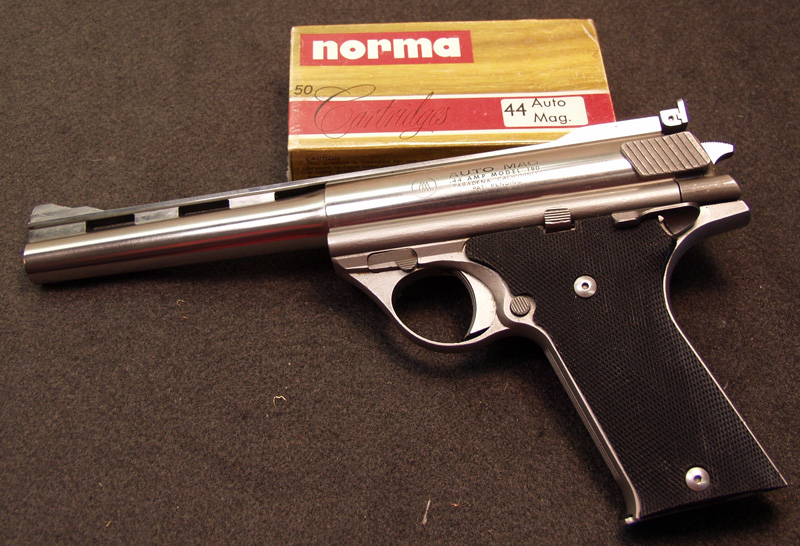
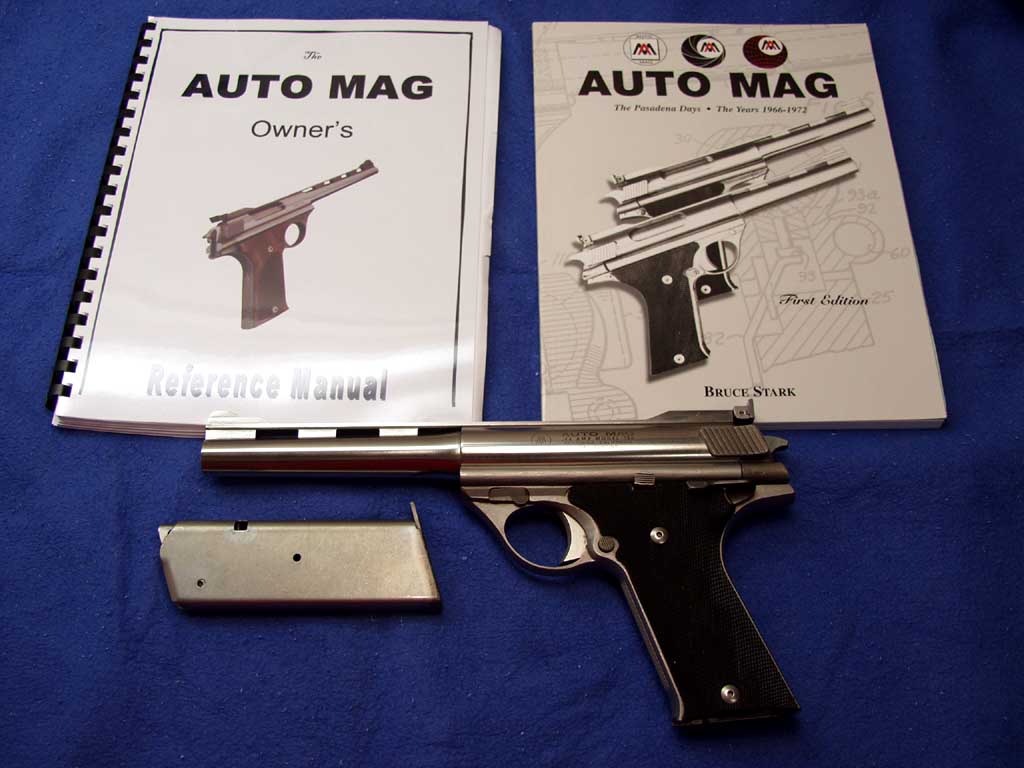
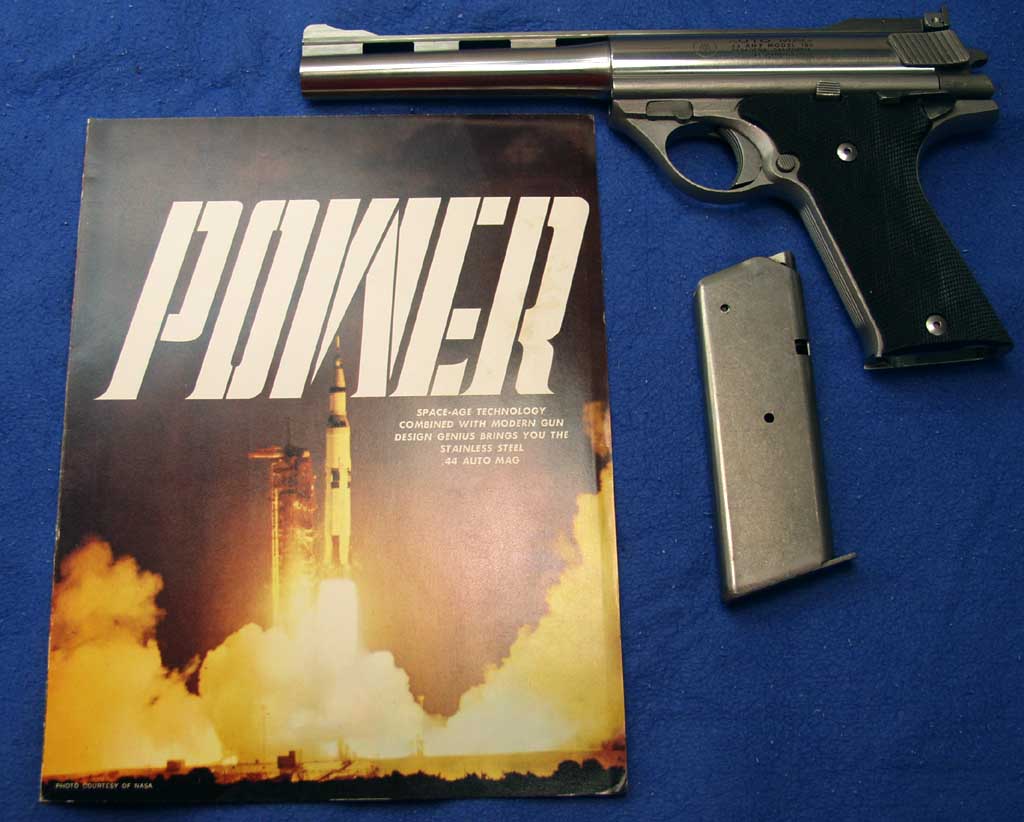
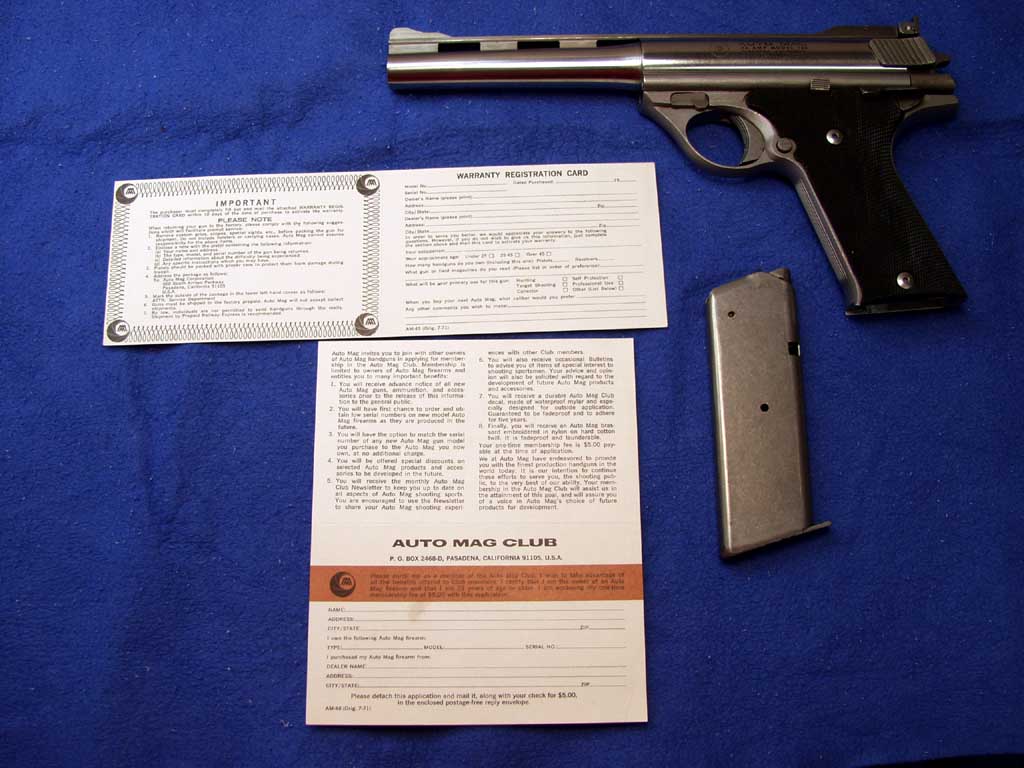
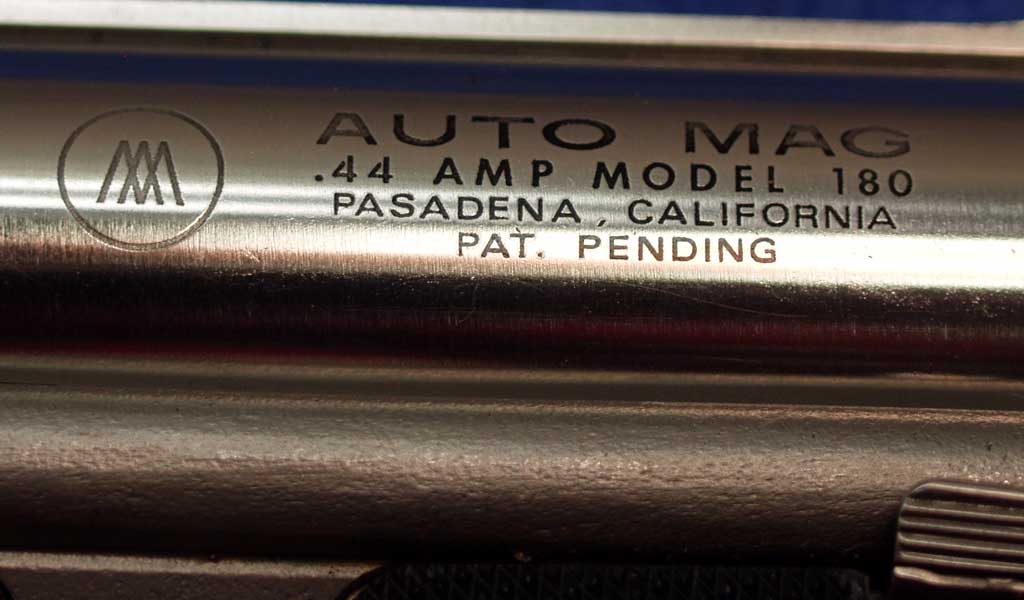
I can't add much other than pictures so what the heck. I love mine!
HisSoldier
New member
I read an analysis once that made a lot of sense, about all large heavy super powerful handguns, especially semi autos. It pointed out that most people who are going to pack something as large and heavy and powerful as those, and the Desert Eagles, and the Mars for that matter, are just more likely to carry the extra range, accuracy and power of a long gun.
The one niche I see is the "Macho" factor, "Mine is bigger than yours" type thinking. If that is true most guys will avoid being cast into that kind of narcissistic ego wrought image, though a few thrive on it.
Having said all that, I always wished it weren't true, if it is, because for one thing all of them use a rotating bolt like a rifle, which is a very strong way to contain such pressures. But not being one who is willing to even pack my own body very far doing so with a heavy large handgun doesn't make much sense to me. Most people would not want to hike into the mountains with one on their hip, for no real advantage over a .44 magnum revolver which, I suggest, is easier to carry.
So then, if most people don't want to carry one, they become point defense weapons, and that may have a place. Accuracy? With scope? Now no one wants to pack it, even Mr. Macho.
FWIW, it seems to me that most of those reasons bounce around inside the minds of people considering such a purpose. I had a nice Deasert Eagle offered to me at a nice price, but it didn't seem like it would be at home in the house on the nightstand, and again, I didn't want to carry it, so what's left?
The one niche I see is the "Macho" factor, "Mine is bigger than yours" type thinking. If that is true most guys will avoid being cast into that kind of narcissistic ego wrought image, though a few thrive on it.
Having said all that, I always wished it weren't true, if it is, because for one thing all of them use a rotating bolt like a rifle, which is a very strong way to contain such pressures. But not being one who is willing to even pack my own body very far doing so with a heavy large handgun doesn't make much sense to me. Most people would not want to hike into the mountains with one on their hip, for no real advantage over a .44 magnum revolver which, I suggest, is easier to carry.
So then, if most people don't want to carry one, they become point defense weapons, and that may have a place. Accuracy? With scope? Now no one wants to pack it, even Mr. Macho.
FWIW, it seems to me that most of those reasons bounce around inside the minds of people considering such a purpose. I had a nice Deasert Eagle offered to me at a nice price, but it didn't seem like it would be at home in the house on the nightstand, and again, I didn't want to carry it, so what's left?
What's left?! 
Same thing as a calculated 94% of the firearms I own: fun, enjoyment, range time, aiming at targets and hitting them, pride of ownership and taking in the artistic craftsmanship in the device.
I will never understand people who miss that entirely. Robotic, mechanized thinking. Bland, colorless, pitiful. It's sad.
Same thing as a calculated 94% of the firearms I own: fun, enjoyment, range time, aiming at targets and hitting them, pride of ownership and taking in the artistic craftsmanship in the device.
I will never understand people who miss that entirely. Robotic, mechanized thinking. Bland, colorless, pitiful. It's sad.
Regarding the post by HisSoldier.
In other words, the .44AMP is so big and unweildly that it may as well be a small carbine, thus missing the whole point of a pistol, a small gun that can be easily carried in a pocket or holster in case you need a gun.
This is also true of its big boomer competition, especially when you start putting scopes on them, they become so big and unweildly that it begs the question "what have you got against rifles?"
This, in short is why this and it's big boomer competition will always be novelty guns for a niche market.
In other words, the .44AMP is so big and unweildly that it may as well be a small carbine, thus missing the whole point of a pistol, a small gun that can be easily carried in a pocket or holster in case you need a gun.
This is also true of its big boomer competition, especially when you start putting scopes on them, they become so big and unweildly that it begs the question "what have you got against rifles?"
This, in short is why this and it's big boomer competition will always be novelty guns for a niche market.
